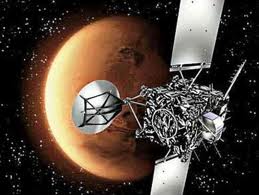
08 Mar EARTH MATTERS: SECRETS OF THE RED PLANET

Mars probe
Time travel, a popular topic of science fiction, has taken one step closer to reality. I am not talking about humans traveling “Back to the Future” as depicted by Hollywood, but rather the use of cutting edge scientific research in the present to reveal the mysteries of the past.
As the majority of our global society spins its wheels in political gridlock trying to go forward while a minority remains stuck in the muddy past, the Mars probe and rover have facilitated the advancement of science.
Equipped with surface-penetrating radar, a NASA probe has discovered the secrets that lie beneath the dusty surface of our mysterious neighbor, the planet Mars. To the delight of scientists worldwide, the Mars Probe has revealed that “the face of Mars is dotted with a maze of channels, pointing to possible ancient megaflood episodes.” The channels were hidden from previous image-capturing probes because of ash deposited by ancient volcanic activity that occurred during the planet’s formation.
Although the data received from the Mars probe primarily serves to advance our understanding of Mars’ geology, it could potentially help to solve the mystery of the origin of water on Earth.
If comets, trans-Neptunian objects, or water-rich meteorites (protoplanets) brought water to Earth, then we could theorize that the same action could have happened on Mars. If the data from the Mars was used to identify potential impact zones created by protoplanets as seen on Earth, scientists could theorize that the formation of Earth’s ocean was partly due to extraterrestrial sources in conjunction with existing water molecules trapped in the Earth’s crust that were released during a significant extraterrestrial impact such as the formation of the moon, which also caused a dense formation of greenhouse gases to be emitted into Earth’s atmosphere.
As a consequence of the concentrated greenhouse gases, the water molecules were trapped in the atmosphere during Earth’s formation as surface temperatures exceeded 2000 C. Over time, as the planet cooled and impact-induced greenhouse gases dissipated into space, the Earth’s energy balanced, which stimulated life on Earth.
In contrast, Mars did not experience such a dramatic greenhouse gas event as seen on Earth and consequently the water molecules deposited on Mars by comets, trans-Neptunian objects, or water-rich meteorite (protoplanets) impacts eventually dissipated into space, thus not contributing to creating a sequence of events that fostered life on Earth, as we know it.


Sorry, the comment form is closed at this time.